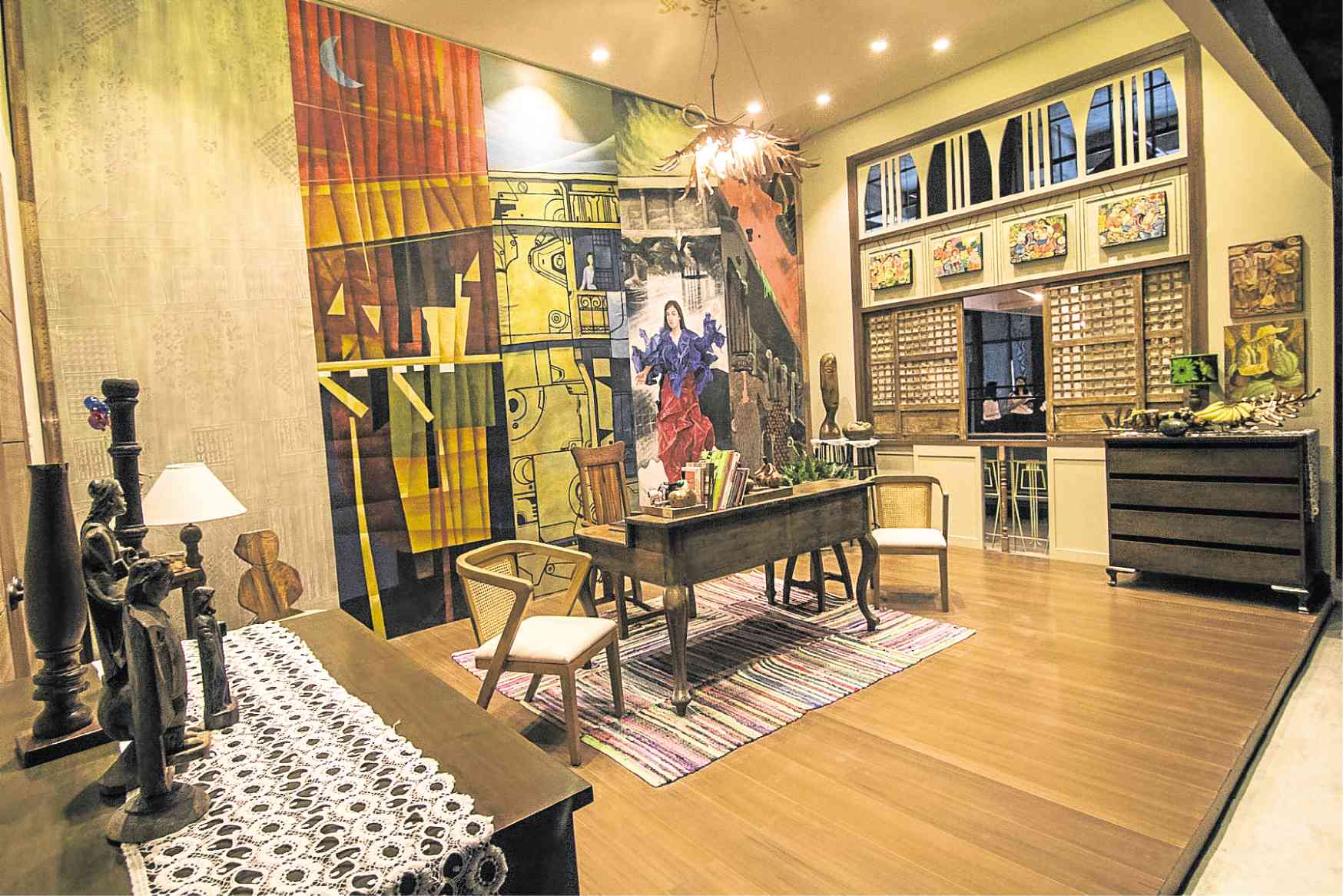by Anson Yu

One of the most interesting residences in Manila is the Bahay Nakpil-Bautista in Quiapo. It was build by Dr. Ariston Bautista in 1914 after he got married to his wife Petronas Nakpil. But aside from its age and its architecture, what make it unique are its connections to Philippine history. Among others, this was where Gregoria de Jesus, the widow of revolutionary Andres Bonifacio, lived until her death in 1943. She moved into the house after she married Petronas’ younger brother, the composer, Julio Nakpil. But as famous as she was, Gregoria knew her place. In all humility she would always consider Petronas as the true lady of the house.
What many people don’t know is that Petronas herself is a very fascinating person. When career opportunities for women were limited, she was one of the few Filipina painters in the early 20th century. She was renown as a painter having won several awards. The government even sent two of her paintings to be part of an exhibit at the Philippine Pavilion during the 1904 St. Louis World Fair.
After her marriage to Dr. Bautista, Petronas became involved with her family’s jewelry business, Joyeria Nakpil. She would handle customer relations and sales by meeting with clients in the special Joyeria room at the Bahay Nakpil. The Joyeria Nakpil reached the height of its popularity in the 1930s when it developed a reputation for fine jewelry. Unfortunately the Joyeria Nakpil lasted until the 1960s when the family decided it was time to close it.
Today the Bahay Nakpil-Bautista is open to the public as a museum. Most of the rooms in the house are now galleries focusing on the lives of four of the house most famous occupants; Dr. Ariston Bautista, Petronas Nakpil, Julio Nakpil and Gregoria de Jesus. But the Joyeria room has been set aside and been made as a tribute to the jewelry atelier.
Currently on view at the Joyeria is the painting “Ang limang tanawan nang Bahay Nakpil.” The work is the result of a commission by the house’s curator, Mary Ann Venturina Bulanadi. Inspired by the story of the Petronas Nakpil-Bautista and the Joyeria Nakpil, she decided to recreate the room for an exhibit at the Philippine School of Interior Design (PSID) where she also teaches.
The exhibit was going to be a special one as it celebrates the school’s 50th anniversary. So Ms. Bulanadi decided to recreate the Joyeria Nakpil room as an art collector’s den. For a showstopper, Ms Bulanadi wanted an original piece of art to make her design stand out. She then thought of a very big painting that would cover one of the walls of her booth. But instead of having it painted by one artist, it would be done by five artists.
But the painting will be more than just decorative. Ms. Bulanadi intends to sell the painting in order to raise money for the Bahay Nakpil. That is because the house is in needs of repair and restoration. One of the rooms where the money is desperately needed is the kitchen. Currently the house does not have a working kitchen. This is a hindrance, especially when there is a seminar or talk held at the house. The money raise from the sale of the painting will help not only in upgrading all the wiring and plumbing in the kitchen, but will also help in acquiring new fixtures and appliances such as refrigerator and cabinetry.
After much thought, Ms Bulanadi came up with five artists to work on the painting. They were Alfred Galvez, Julius Legaspi, Derrick Macutay, Abe Orobia and Jared Yokte. It was going to be a challenge as each of the artists was distinct in their style, choice of medium and inspiration. Alfred Galvez for example moonlights as an art conservator, so his style is inspired by the older generation of painters. Julius Legaspi depicts everyday scene and still life using watercolor and pastel. Derrick Macutay’s works explores the relationship between man and technology. Abe Orobia explores themes that relates of Philippine identity, culture and tradition, while Jared Yokte finds his inspiration in his own family life. As to why they were her choices…“ I believed in their talents. I have faith in them that they will be able to give justice to my criteria, which is to depict the Bahay Nakpil in their own distinct style. I also chose them because they are close to my heart and I have worked with them on previous occasion.“
It was in January of 2017 that Ms. Bulanadi met with each of the artists individually to discuss about their participation in the project. When they agreed, she brought them to the house to get inspiration. Upon learning the history of the house and the condition it was currently in, the artists agree that the project was indeed important. They all agreed to donate their talent to help raise money for the house’s repair.
To help pay for the cost of production, Ms. Bulanadi would provide for the canvaspaint The size of the canvas given to each artist measured four meter by one and half meter canvas. As for the paint, they were provided by one of the project’s sponsor, Boysen Paint.
For most part, Ms. Bulanadi left the artists alone as they work. Some like Mr. Orobia and Mr. Yokte were in constant communication with each other, but the rest worked alone or with their assistant. It was not until July that the artists began submitting their work to Ms. Bulanadi.
When all of the artists submitted their works, Ms. Bulanadi then began assembling the paintings alphabetically by the family name of each of the artist. Taking a step backward, she was happy with what she saw. The result was epic to say the least. Despite the diversity in their styles, their work came together beautifully.
There were some surprises though, while Mr. Macutay, Mr. Orobia and Mr. Yokte stayed true to their style, Mr. Galvez and Mr. Legaspi took the risk and experimented with different style. Mr. Legaspi took a break from his realism and tried out cubism. Mr. Galvez on the other hand decided to skip colors altogether and opted for a color palette of grey and white. Mr. Galvez later admitted that it was a deliberate choice. He wanted to complement the more modern style of the other artists, but at the same time stand out.
To make the recreated room look like a real art collector’s den, Ms Bulanadi needed pieces that are representative of Philippine modern art. Her contacts at Art Circle Gallery loaned her paintings by Norma Belleza, Anthony Geduspan and Eberle Catamponga. They also lent her sculptures by Ronald Castrillo. Ms. Bulanadi also had a lot of help from her wide circle of friends. Watercolor artist, Tet Ureta Aligaen, contributed metal décor pieces such as a fern inspired chandelier and a fruit bowl. Former student, Cha Ignacio Salcedo of Oliohouse Furniture, provided a painting cabinet. Madel Cadapang supplied sculptures by her late mother’s Inday Cadapan. Artist Ding Royales and Von Enriquez lend a hand by providing painted details to the ceiling of the room as well as hand crafted rug.
To balance out the modern artwork, Ms. Bulanadi borrowed an antique escritoria from Leo Gallery. She balanced this with an armchair by Agi Kalinawan and a guest chair from Kirby Ricohermoso. She even went out of her way to acquire pieces with very unusual backstory. These were the capiz windows from a Chinese school that had close down and was being demolished in Binondo.
By September, the construction of the art collector’s den was in full swing. The various art pieces, furniture, accent piece and the painting were transported to the site of the exhibit at Uptown Mall in Bonifacio Global City. In the midst of all this, Ms Bulanadi was in a state of excitement, as she was eager for the public to see the painting.
On the first of October, the PSID 50th anniversary exhibit entitled, Gold, officially opened. Ms Bulanadi’s art collector’s den was among the fifty booths on display at the exhibit. It quickly caught the attention of the media and visitors for its warm vibrant colors and its celebration of Filipino art and culture. It quickly became a crowd favorite.
After exhibit ended on October 31st, the den was disassembled. All the furniture, art works and accent piece were returned to the various galleries and artists. The painting was taken to the Bahay Nakpil where it was displayed in the Joyeria room. Maria Santos Viola, one of the board member of the Bahay Nakpil, was apprehensive at first. “First of all, it was a modern piece of art which contrasted sharply with the century old decor of the house. Secondly I was concern with factors like security and exposure to sunlight.” But when the painting was unveiled, she changed her mind. “It made the house come alive!” Despite it being a modern piece of art, Ms Santos Viola feels that what made it blend with the house is Filipiniana theme. She also noticed that the painting always catches the attention of the visitors to the house.
But the painting won’t stay in the house forever. It must be sold in order to raise money for Bahay Nakpil’s repair and rehabilitation. This way the Bahay Nakpil-Bautista will continue to inform and inspire Filipinos for generations to come.































